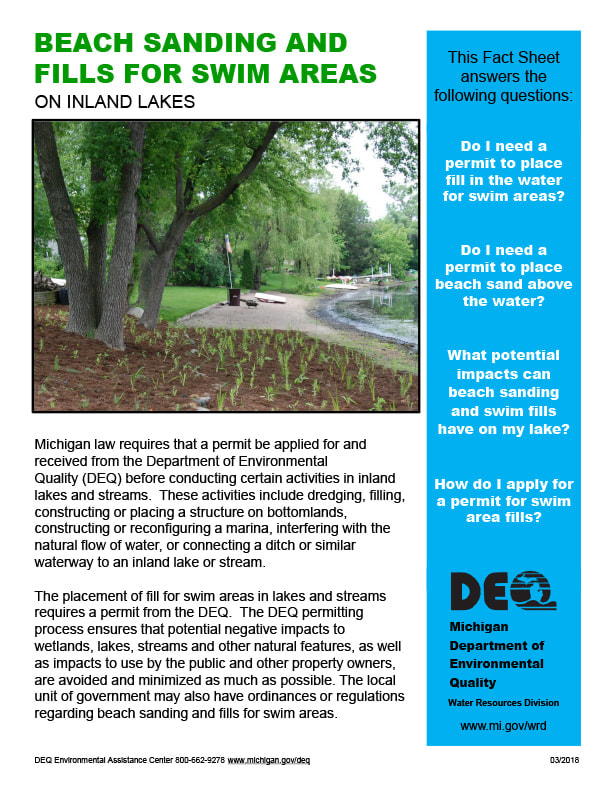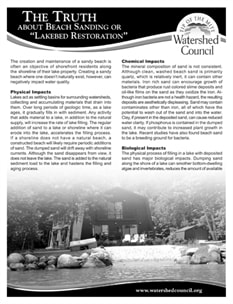Beach Sanding or "Lakebed Restoration"
The creation and maintenance of a sandy beach is often an objective of shorefront residents along the shoreline of their lake property. Creating a sandy beach where one doesn’t naturally exist, however, can negatively impact water quality.
Physical Impacts
Lakes act as settling basins for surrounding watersheds, collecting and accumulating materials that drain into them. Over long periods of geologic time, as a lake ages, it gradually fills in with sediment. Any activity that adds material to a lake, in addition to the natural supply, will increase the rate of lake filling. The regular addition of sand to a lake or shoreline where it can erode into the lake, accelerates the filling process. If a shoreline does not have a natural beach, a constructed beach will likely require periodic additions of sand. The dumped sand will drift away with shoreline currents. Although the sand disappears from view, it does not leave the lake. The sand is added to the natural sediment load to the lake and hastens the filling and aging process.
Physical Impacts
Lakes act as settling basins for surrounding watersheds, collecting and accumulating materials that drain into them. Over long periods of geologic time, as a lake ages, it gradually fills in with sediment. Any activity that adds material to a lake, in addition to the natural supply, will increase the rate of lake filling. The regular addition of sand to a lake or shoreline where it can erode into the lake, accelerates the filling process. If a shoreline does not have a natural beach, a constructed beach will likely require periodic additions of sand. The dumped sand will drift away with shoreline currents. Although the sand disappears from view, it does not leave the lake. The sand is added to the natural sediment load to the lake and hastens the filling and aging process.
Chemical Impacts
The mineral composition of sand is not consistent. Although clean, washed beach sand is primarily quartz, which is relatively inert, it can contain other materials. Iron rich sand can encourage growth of bacteria that produce rust colored slime deposits and oil-like films on the sand as they oxidize the iron. Although iron bacteria are not a health hazard, the resulting deposits are aesthetically displeasing. Sand may contain contaminates other than iron, all of which have the potential to wash out of the sand and into the water. Clay, if present in the deposited sand, can cause reduced water clarity. If phosphorus is contained in the dumped sand, it may contribute to increased plant growth in the lake. Recent studies have also found beach sand to be a breeding ground for bacteria.
The mineral composition of sand is not consistent. Although clean, washed beach sand is primarily quartz, which is relatively inert, it can contain other materials. Iron rich sand can encourage growth of bacteria that produce rust colored slime deposits and oil-like films on the sand as they oxidize the iron. Although iron bacteria are not a health hazard, the resulting deposits are aesthetically displeasing. Sand may contain contaminates other than iron, all of which have the potential to wash out of the sand and into the water. Clay, if present in the deposited sand, can cause reduced water clarity. If phosphorus is contained in the dumped sand, it may contribute to increased plant growth in the lake. Recent studies have also found beach sand to be a breeding ground for bacteria.
Biological Impacts
The physical process of filling in a lake with deposited sand has major biological impacts. Dumping sand along the shore of a lake can smother bottom-dwelling algae and invertebrates, reduces the amount of available habitat, and may cause a disruption in the food chain of higher organisms including fish. Deposited sand may also destroy spawning or nesting sites for fish. Turbidity from the deposited sand may clog gills and interfere with normal fish behavior. A shallower lake has less volume of water to dilute and assimilate incoming contaminants, including phosphorus. With a constant level of phosphorus input, a lake's productivity (algae growth) will increase as the lake's depth decreases. Also, as a lake becomes shallower, more sunlight hits the lake-bottom and thus, there is greater potential for increased rooted plant growth.
The physical process of filling in a lake with deposited sand has major biological impacts. Dumping sand along the shore of a lake can smother bottom-dwelling algae and invertebrates, reduces the amount of available habitat, and may cause a disruption in the food chain of higher organisms including fish. Deposited sand may also destroy spawning or nesting sites for fish. Turbidity from the deposited sand may clog gills and interfere with normal fish behavior. A shallower lake has less volume of water to dilute and assimilate incoming contaminants, including phosphorus. With a constant level of phosphorus input, a lake's productivity (algae growth) will increase as the lake's depth decreases. Also, as a lake becomes shallower, more sunlight hits the lake-bottom and thus, there is greater potential for increased rooted plant growth.
Local Protection Activities
Local residents and lake association members can help protect a lake from excessive sand dumping by:
Local residents and lake association members can help protect a lake from excessive sand dumping by:
- Educating residents, association members, and town officials about the requirement for a state permit to create or enhance a beach, and about the negative impacts of such activities even though they may be legal and permits are available.
- Encouraging association members to minimize the use of sand dumping by adopting an association policy to that effect.
- Working with town officials to adopt a local ordinance to prohibit or restrict the use of sand dumping along lake shores and within lakes.
- Reporting illegal sand dumping incidents to the Michigan Department of Environmental Quality (MDEQ).
Permits
Filling for the creation and improvement of swimming areas and beaches requires a permit from ELGE Water Resources Division and potentially the need for a county soil erosion permit. Placement of sand, pea stone, or other clean fill below (waterward) of the water line requires a permit. A reasonable amount of sand may be placed landward of the water line without a permit as long as the sand does not shift the location of the existing ordinary high water mark or the shoreline contour. The sand cannot be placed in a wetland. For more information on permitting and additional information on which local, state, and federal permits may be needed, contact the Inland Lakes and Streams Program at (517) 241-4512 or www.michigan.gov/egle.
Filling for the creation and improvement of swimming areas and beaches requires a permit from ELGE Water Resources Division and potentially the need for a county soil erosion permit. Placement of sand, pea stone, or other clean fill below (waterward) of the water line requires a permit. A reasonable amount of sand may be placed landward of the water line without a permit as long as the sand does not shift the location of the existing ordinary high water mark or the shoreline contour. The sand cannot be placed in a wetland. For more information on permitting and additional information on which local, state, and federal permits may be needed, contact the Inland Lakes and Streams Program at (517) 241-4512 or www.michigan.gov/egle.
Creating a sandy beach where one doesn’t naturally exist can negatively impact water quality. Please contact Tip of the Mitt Watershed Council at (231) 347-1181 to discuss beach sanding or if you have any questions about this topic. We are here to help you make an informed decision when considering beach sanding on your waterfront property.
Additional Resources





